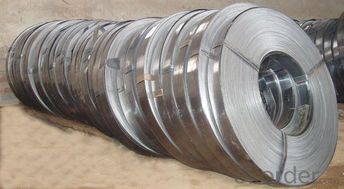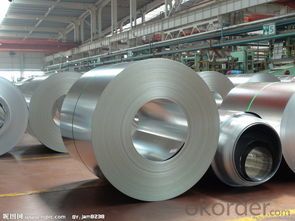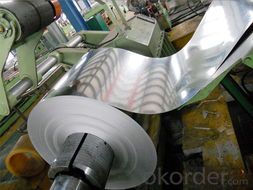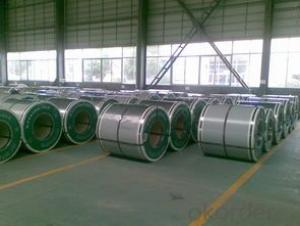Hot Sale Hot-dip Zinc Coating Steel Building Roof Walls
- Loading Port:
- China main port
- Payment Terms:
- TT OR LC
- Min Order Qty:
- 50 m.t.
- Supply Capability:
- 10000 m.t./month
OKorder Service Pledge
OKorder Financial Service
You Might Also Like
Hot-dip Zinc Coating Steel Building Roof Walls
1.Structure of Hot-Dip Galvanized Steel Sheet Description:
Hot-dip galvanized steel coils are available with a pure zinc coating through the hot-dip galvanizing process. It offers the economy, strength and formability of steel combined with the corrosion resistance of zinc. The hot-dip process is the process by which steel gets coated in layers of zinc to protect against rust. It is especially useful for countless outdoor and industrial applications. Production of cold formed corrugated sheets and profiles for roofing, cladding, decking, tiles, sandwich walls, rainwater protective systems, air conditioning duct as well as electrical appliances and engineering.
2.Main Features of the Hot-Dip Galvanized Steel Sheet:
• Excellent process capability
• Smooth and flat surface
• Workability, durability
• Excellent anticorrosive property
• High strength
• Good formability
• Good visual effect
3.Hot-Dip Galvanized Steel Sheet Images



4.Hot-Dip Galvanized Steel Sheet Specification
Standard: ASTM, JIS,EN
Grade: CS, DX51D+Z,SGCC, SS 230~550,S220GD+Z~S550GD+Z, SGC340~SGC570
Thickness: 0.18mm~5mm
Width: max 2000mm
Coil weight:3-12 MT
Coil ID:508/610mm
Surface structure: zero spangle, regular spangle or minimum spangle
Surface treatment: Chromate treatment, Oiled/dry, skinpassed/non-skinpassed
Packing: Standard seaworthy export package
Technology test results:
Processability | Yield strength | Tensile strength | Elongation % | 180°cold-bending |
Common PV | - | 270-500 | - | d=0,intact,no zinc removal |
Mechanical interlocking JY | - | 270-500 | - | d=0,intact,no zinc removal |
Structure JG | >=240 | >=370 | >=18 | d=0,intact,no zinc removal |
Deep drawn SC | - | 270-380 | >=30 | d=0,intact,no zinc removal |
EDDQ SC | - | 270-380 | >=30 | d=0,intact,no zinc removal |
5.FAQ of Hot-Dip Galvanized Steel Sheet
We have organized several common questions for our clients,may help you sincerely:
1.How about your company?
A world class manufacturer & supplier of castings forging in carbon steel and alloy steel,is one of the large-scale professional investment casting production bases in China,consisting of both casting foundry forging and machining factory. Annually more than 8000 tons Precision casting and forging parts are exported to markets in Europe,America and Japan. OEM casting and forging service available according to customer’s requirements.
2.How to guarantee the quality of the products?
We have established the international advanced quality management system,every link from raw material to final product we have strict quality test;We resolutely put an end to unqualified products flowing into the market. At the same time, we will provide necessary follow-up service assurance.
3. How long can we receive the product after purchase?
Usually within thirty working days after receiving buyer’s advance payment or LC. We will arrange the factory manufacturing as soon as possible. The cargo readiness usually takes 15-30 days, but the shipment will depend on the vessel situation.
- Q:Hi! does anyone know where can i find a building with a structure of steel frames, i need to do an analysis for school so i need joint details, girder details and such! PLEASE help me! thanks
- if u need to analyse a steel framed structure for joint details the best example would be of a mechanic workshop...the truss of such a workshop is always supported on a portal frame and in most of the case thats a steel structure...do keenly observe the joints at the footing plates that is connected to the girder section...nd also observe the joints in truss of such a frame....myslf m a civil engg. student.
- Q:it isn't a SIGG water bottle or any other brand, as it's from thingsengraved what I'm wondering is, is this just as good as a SIGG water bottle, or is there any difference?
- Stainless steel is one of the best products to use for anything associated with food. It can be sterilized, it won't stain or absorb odors, it can be recycled and much of it is made of recycled material. If you take care of it, it can last a lifetime. We get hung up on brand names, you should look at the material it is made of. Which is a quality grade of stainless steel. I couldn't find the grade on the Sigg site, but I would think it would be the same or very similar. So, all that to say, this one seems to be as good as a Sigg.
- Q:Can steel coils be coated with anti-microbial materials?
- Yes, steel coils can be coated with anti-microbial materials. These coatings are designed to inhibit the growth of microorganisms on the surface, providing added protection against bacterial or fungal contamination.
- Q:What are the factors to consider when selecting steel coils for a specific application?
- There are numerous factors to consider when choosing steel coils for a particular application. These factors encompass the type of application, the necessary strength and durability, the desired aesthetic appearance, the allocated budget, and any specific industry standards or regulations that must be met. Firstly, it is crucial to identify the type of application for which the steel coils will be utilized. Various applications may necessitate different steel types with varying properties. For instance, if the coils are intended for use in structural construction, high-strength steel with exceptional structural integrity may be necessary. Conversely, if the coils will be employed in automotive manufacturing, steel with good formability and weldability may be more appropriate. The required strength and durability represent another crucial factor to contemplate. This includes factors such as load-bearing capacity, resistance to corrosion, and the ability to withstand extreme temperatures or environmental conditions. The selected steel coils must be capable of enduring the specific stresses and strains inherent in the intended application. The desired aesthetic appearance is also significant, particularly in applications where the steel coils will be visible. Considerations may include the surface finish, color, and texture of the steel coils. This consideration is especially pertinent in industries such as architecture or interior design, where the visual appeal of the steel plays a pivotal role. Budgetary constraints should also be taken into account when selecting steel coils. The price of different steel grades and types can vary significantly. Striking a balance between desired properties and available budget is important. In some cases, compromising on certain factors may be necessary in order to adhere to financial limitations. Lastly, any specific industry standards or regulations must be considered during the selection process. Certain industries, such as aerospace or automotive, may impose strict requirements on the materials used in their products. It is essential to ensure that the chosen steel coils meet all necessary standards and regulations in such cases. In conclusion, when choosing steel coils for a specific application, careful consideration should be given to factors such as the type of application, required strength and durability, desired aesthetic appearance, budget, and industry standards or regulations. By taking these factors into account, an informed decision can be made to select the most suitable steel coils for the intended application.
- Q:What are the common methods of recoiling steel coils?
- There are several common methods of recoiling steel coils, depending on the specific requirements and preferences of the manufacturer or customer. One common method is known as slitting, which involves cutting the wide steel coil into narrower strips. This is achieved by passing the coil through a set of rotating circular blades that cut the steel into multiple smaller coils with desired widths. Slitting is commonly used to create coils of different sizes for various applications. Another method is called cut-to-length (CTL) recoiling, where the steel coil is cut into specific lengths as per the customer's requirements. This process involves feeding the coil through a straightening and leveling machine, followed by a flying shear that cuts the steel into desired lengths. CTL recoiling is often used in industries where precision and uniformity of steel lengths are crucial, such as construction or automotive. Additionally, there is a method called coil-to-coil recoiling, which involves rewinding the steel coil onto a new coil, with the desired dimensions and properties. This process is commonly used when the original coil needs to be resized, reconditioned, or rerolled for further processing or transportation purposes. Coil-to-coil recoiling is often done using specialized recoiling machines that ensure the proper tension, alignment, and winding of the steel coil onto the new coil. Overall, the common methods of recoiling steel coils include slitting, cut-to-length (CTL) recoiling, and coil-to-coil recoiling. Each method offers its own advantages and is chosen based on factors such as required coil dimensions, precision, efficiency, and the specific needs of the industry or customer.
- Q:It seems that steel would be stonger and more stable than wood, fire resistant, and better for the environment, so why are most homes wood-framed rather than steel-framed?
- In most locations a 2x4 is slightly cheaper than a steel stud. The labor is cheaper with wood because it's less skilled and there are many people to swing a hammer cheaply. Most contractors do what they know and most only know wood.
- Q:engineering sloutions related to steel fabrication
- The American Institute of Steel Construction develops codes for steel building design in the U.S. See the link to below to the Steel Solutions Center at their website. You can find free programs for designing structural steel elements from clicking on technical resources at that link. Most of the programs presume that you are a structural/civil engineer with knowledge of the steel design specifications.
- Q:What are the dimensions of steel coils used in the building materials industry?
- The dimensions of steel coils used in the building materials industry can vary depending on the specific requirements of the project. However, common dimensions for steel coils in this industry range from 0.15mm to 3.5mm in thickness and 600mm to 2000mm in width. The length of the coils can also vary, typically ranging from 1000mm to 6000mm.
- Q:How do steel coils differ in terms of size and weight?
- The size and weight of steel coils can vary greatly depending on their intended use and production process. When it comes to size, a steel coil is typically measured by its outer diameter, inner diameter, and width. The outer diameter refers to the total diameter of the coil, while the inner diameter refers to the diameter of the hollow center. The width, on the other hand, is the distance between the two flat sides. In terms of weight, steel coils can range from a few hundred pounds to several tons. The weight primarily depends on the size and type of steel used. Coils made from high-strength steel are generally heavier because they have a higher density. On the contrary, coils made from lower-grade steel can be lighter. The size and weight of steel coils play a crucial role in their transportability and handling. Smaller and lighter coils are easier to handle and transport, making them suitable for applications that require maneuverability. On the flip side, larger and heavier coils are commonly used in industries that prioritize strength and durability, like construction and automotive manufacturing. All in all, steel coils come in various sizes and weights, allowing for customization and meeting specific requirements in different industries.
- Q:What are the dimensions of a steel coil?
- The dimensions of a steel coil can vary depending on its intended use and manufacturer. However, typical dimensions include a width ranging from 600mm to 2,200mm, a diameter of 600mm to 2,000mm, and a weight ranging from a few hundred kilograms to several metric tons.
1. Manufacturer Overview |
|
|---|---|
| Location | |
| Year Established | |
| Annual Output Value | |
| Main Markets | |
| Company Certifications | |
2. Manufacturer Certificates |
|
|---|---|
| a) Certification Name | |
| Range | |
| Reference | |
| Validity Period | |
3. Manufacturer Capability |
|
|---|---|
| a)Trade Capacity | |
| Nearest Port | |
| Export Percentage | |
| No.of Employees in Trade Department | |
| Language Spoken: | |
| b)Factory Information | |
| Factory Size: | |
| No. of Production Lines | |
| Contract Manufacturing | |
| Product Price Range | |
Send your message to us
Hot Sale Hot-dip Zinc Coating Steel Building Roof Walls
- Loading Port:
- China main port
- Payment Terms:
- TT OR LC
- Min Order Qty:
- 50 m.t.
- Supply Capability:
- 10000 m.t./month
OKorder Service Pledge
OKorder Financial Service
Similar products
New products
Hot products
Related keywords





























